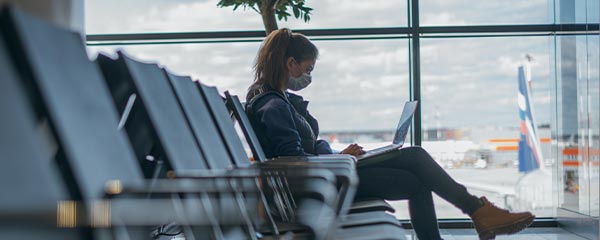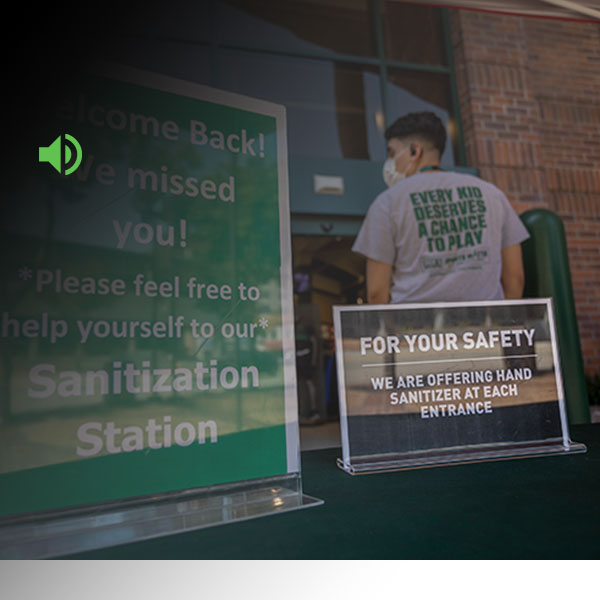Story Highlights
- Americans' likelihood to visit businesses has changed little since July
- Grocery store, pharmacy visits vary little by COVID-19 perceptions
- Use of nonessential services more strongly related to views of pandemic
Editor's Note: The research below was conducted in partnership between Franklin Templeton and Gallup.
WASHINGTON, D.C. -- Americans' likelihood to engage in consumer behavior that requires them to visit public places changed little between July and August, according to the Franklin Templeton-Gallup Economics of Recovery Study. Almost six in 10 Americans currently say they or others in their household have visited a grocery store in the past 48 hours, while two in 10 say the same about restaurants and pharmacies. For several other consumer services -- including salons, public transportation and hotels -- no more than 7% of Americans currently respond this way.
| July 2020 | August 2020 | ||||||||||||||||||||||||||||||||||||||||||||||||||||||||||||||||||||||||||||||||||||||||||||||||||
|---|---|---|---|---|---|---|---|---|---|---|---|---|---|---|---|---|---|---|---|---|---|---|---|---|---|---|---|---|---|---|---|---|---|---|---|---|---|---|---|---|---|---|---|---|---|---|---|---|---|---|---|---|---|---|---|---|---|---|---|---|---|---|---|---|---|---|---|---|---|---|---|---|---|---|---|---|---|---|---|---|---|---|---|---|---|---|---|---|---|---|---|---|---|---|---|---|---|---|---|
| % | % | ||||||||||||||||||||||||||||||||||||||||||||||||||||||||||||||||||||||||||||||||||||||||||||||||||
| Grocery store | 56 | 57 | |||||||||||||||||||||||||||||||||||||||||||||||||||||||||||||||||||||||||||||||||||||||||||||||||
| Restaurant | 19 | 20 | |||||||||||||||||||||||||||||||||||||||||||||||||||||||||||||||||||||||||||||||||||||||||||||||||
| Pharmacy | 19 | 19 | |||||||||||||||||||||||||||||||||||||||||||||||||||||||||||||||||||||||||||||||||||||||||||||||||
| Gym | 6 | 7 | |||||||||||||||||||||||||||||||||||||||||||||||||||||||||||||||||||||||||||||||||||||||||||||||||
| Salon or barbershop | 7 | 7 | |||||||||||||||||||||||||||||||||||||||||||||||||||||||||||||||||||||||||||||||||||||||||||||||||
| Public transportation | 5 | 6 | |||||||||||||||||||||||||||||||||||||||||||||||||||||||||||||||||||||||||||||||||||||||||||||||||
| Spent the night in a hotel or similar accommodation | 5 | 6 | |||||||||||||||||||||||||||||||||||||||||||||||||||||||||||||||||||||||||||||||||||||||||||||||||
| FRANKLIN TEMPLETON-GALLUP | |||||||||||||||||||||||||||||||||||||||||||||||||||||||||||||||||||||||||||||||||||||||||||||||||||
Though there are differences in some of these measures by demographic categories, such as Americans' age, the lack of change in consumer behavior between July and August is largely consistent across these subgroups. It also holds true at the regional level, where coronavirus infection rates can shift more rapidly than they do nationally.
The current stability conforms with a similar set of questions about consumer behavior that Gallup has asked since March 2020, when the COVID-19 crisis began to disrupt businesses across the country. For more commonly visited places like grocery stores, pharmacies and restaurants, Americans' likelihood to visit (in the past 24 hours) remained at their lowest levels through the end of April, rising somewhat throughout May and early June as some restrictions on businesses began to ease. The frequency of reported visits then stabilized again at a somewhat higher level in late June, where it remained through mid-August.

Line graph. The percentages of Americans who visits grocery stores pharmacies and restaurants in the last 48 hours from March 23 through August 16. From August 10 through 16 52% of Americans say they visited a grocery story. 24% visited a restaurant and 18% went to a pharmacy.
The data also offer evidence that consumers' pre-pandemic habits are important to account for in assessing their likelihood to visit businesses in person during the recovery. For example, those who frequently dined in at restaurants before the pandemic are more likely to currently say they have done so in the past 24 hours.
This relationship can be traced to underlying demographic variables that predict consumer behavior. Among the most important of these is income. For example, the average response when Americans are asked how many times a month they visited restaurants before the pandemic is 4.3 -- but that figure ranges from 2.8 among those with annual household incomes of less than $12,000 to 5.9 among those with incomes of $120,000 or more. Correspondingly, those with the highest incomes are currently about twice as likely as those with the lowest incomes to say they have dined at a restaurant in the past 24 hours.

Vertical bar graph. Higher income Americans were more likely to visit restaurants both before and during the COVID-19 pandemic. Americans earning $120,000 or more a year, averaged 5.9 monthly visits to restaurants and 22% of this group have visited a restaurant in the last 48 hours. Americans earning less than $12,000 more a year, averaged 2.8 monthly visits to restaurants and 12% of this group have visited a restaurant in the last 48 hours.
Americans Optimistic About COVID-19 More Likely to Return to Businesses
The lack of recent change in American consumers' likelihood to shop in person for goods and services suggests most are maintaining a wait-and-see attitude that is resistant to short-term changes in the prevalence of COVID-19. August data on community mobility from Google indicate that visits to retail and recreation remain down 15% from a pre-pandemic baseline, while visits to grocery stores and pharmacies remain down 4%. Currently, the necessity of the goods and services being purchased appears to be more important to consumers' decision to visit a business than their specific views of how the coronavirus situation is progressing.
Thus, Americans' likelihood to shop in person for essential items like food and medical supplies varies little by their perception of whether the COVID-19 situation is getting better or worse. While 51% of those who believe the situation is getting a lot better say they or others in their household have visited a grocery store in the past 48 hours, so do 57% of those who believe the situation is getting a lot worse. Similarly, their likelihood to say they or their household members have visited a pharmacy varies little according to whether they feel the situation is getting better or worse.

Horizontal bar graph. The percentage of Americans who visited a grocery or pharmacy with the last 48 hours, by their level of optimism on the COIVD-19 situation. 61% of Americans who say COVID-19 is getting a lot better have visited a grocery store in the last 48 hours, compared with 57% of those who say it is getting a lot worse. 22% of Americans who say COVID-19 is getting a lot better have visited a pharmacy in the last 48 hours, compared with 20% of those who say it is getting a lot worse.
For less essential goods and services, however, there are significant differences according to perceptions of the COVID-19 situation. Americans' likelihood to say they have visited a restaurant in the past 48 hours declines among those who say the situation is staying the same or getting a little worse, and then again among those who say the situation is getting a lot worse.
For several other nonessential services -- including using public transportation, going to a gym, getting a haircut or spending the night in a hotel -- likelihood of use rises most clearly only among the small proportion of Americans (currently 5% overall) who believe the coronavirus situation is getting a lot better.
Most notably, 19% among this group say they have spent the night in a hotel in the past 48 hours, versus no more than 7% of those who give a less optimistic response when asked for their impression of the coronavirus situation. This finding is particularly noteworthy given that the leisure and hospitality industry has been among the hardest hit by the crisis; one recent analysis of BLS data estimates that 34% of U.S. jobs lost between February and July occurred in that sector alone.

Horizontal bar graph. Americans' use of non-essential services, by their optimism on the COVID-19 situation. 32% of Americans who say the situation has gotten a lot better have visited a restaurant in the last 48 hours, compared with 14% of those who say it is getting a lot worse. 12% of Americans who say the situation has gotten a lot better have used public transportation in the last 48 hours, compared with 5% of those who say it is getting a lot worse. 13% of Americans who say the situation has gotten a lot better have visited a gym in the last 48 hours, compared with 5% of those who say it is getting a lot worse. 12% of Americans who say the situation has gotten a lot better have visited a salon or barbershop in the last 48 hours, compared with 5% of those who say it is getting a lot worse. 19% of Americans who say the situation has gotten a lot better have spent a night in a motel in the last 48 hours, compared with 4% of those who say it is getting a lot worse.
Implications
Many Americans will wait until they have a resolute feeling that conditions are improving before reengaging with services that may be less integral to their daily lives. Thus, the proportion who say the coronavirus situation is getting a lot better may be an important bellwether of changing consumer behavior in the coming months. The Franklin Templeton-Gallup research will continue to track this and a range of other attitudinal indicators with implications for in-person consumer services as the country continues along the path to economic recovery.
To receive ongoing updates about findings from the Franklin Templeton-Gallup Economics of Recovery Study, please sign up here. To read the project announcement press release, please visit this page.




